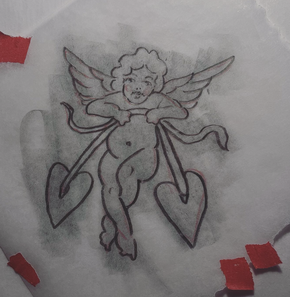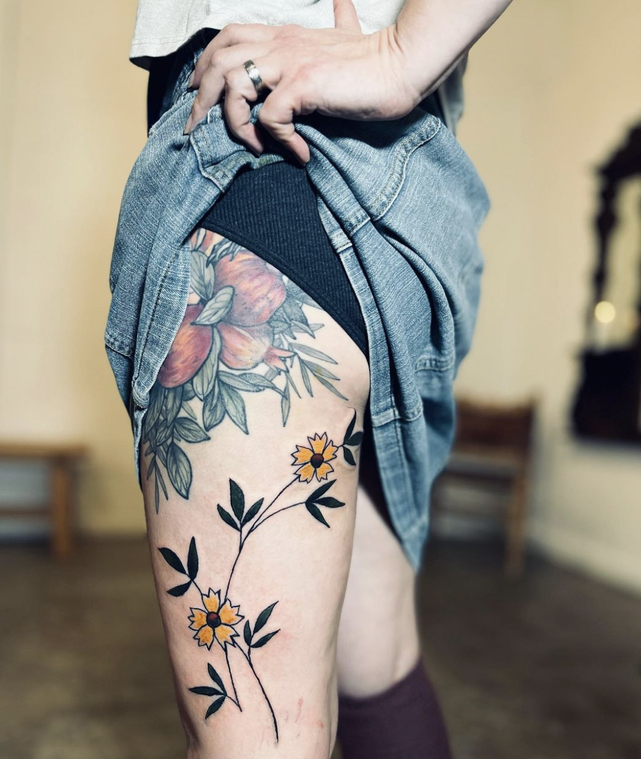
@submissive.hand
In the spring of 2021 I began a sketchbook with my non-dominant hand. “It will be like an apprenticeship,” I decided- “a traditional one.” I opened up a book of Sailor Jerry line drawings and dutifully repainted the hearts and butterflies I remembered becoming familiar with at the beginning of tattooing.
Why these motifs? Why these traditions? I would learn along the way.
Tattooing is fucking hard! When I hear this from a new tattooer it makes me want to laugh and cry at the same time. Thank god, I’m not crazy. It is hard. Mechanically, nothing is like human skin. There are plenty of ways to practice but nothing can prepare you for the paradox of resilience and fragility offered by the medium of skin.
Watercolor paper turns out to be surprisingly good practice- easy to overwork, it mimics the way skin gives up on holding pigment when you ask too much of it.
American Traditional, Classic, Sailor, or Cartoon, whatever you would like to call it- folk imagery is simple to trace, (simple is not easy!) and challenging from scratch. Knowing where to be fluid, where to be precise, letting go of perfectionism, leaving out unnecessary details- these are skills built through practice, but also through a sense of ease that can only be found from not worrying much about the outcome. You want it to look good, not perfect. To look right, not correct.
At the beginning of tattooing, I attempted the classics, over-complicating designs by adding extra details, attempting flair before I had finesse. My mentor shook his head at one of attempts and said, “You’re making it too hard on yourself. Try a rose.”
As I developed the mechanics of tattooing, I began to indulge my scientific side and became a skilled botanical illustrator. I devoted my technical development to accurately, and as poetically as possible, depicting what captivates me about the natural world. I stopped worrying about folk art and made tattoos about plants. I took my mentor’s advice seriously.
Meanwhile I collected printed quilts from India, painted pottery from Mexico, books filled with lace designs, old cigarette boxes with exotic labels. I collected all kinds of tattoos from friends and colleagues, even getting a big panther tattooed across my back. I learned to admire what didn’t come naturally to me and allowed myself to develop my own style alongside it.
Animals besides humans display handedness. The lore of left-handedness is murky, and when it comes to converting lefties to righties, research shares a generalized sense of “people tend to do this, in many places, for various reasons.” Spurred by a childhood memory of Catholic school, I asked ChatGPT, “Why do Catholic people force left-handed children to switch hands?” I was flagged for offensive content, and reminded that it was a generalized behavior, not specific to any one culture.
The experience was uncomfortable. I put on drone sounds, set a timer, and sat down to draw. Even tracing felt weird. I felt an extreme urge to leap out of my chair and run away. When I’d get fatigued, my dominant hand would occasionally reach toward the pen in my other hand, trying to ‘help’ move things along. It felt like I was doing something fun to my brain. Eating with a fork in one hand and a knife in the other started to feel confusing. It took months of dedicated, timed sessions to gain a sense of ease. I dedicated one of my three morning journal pages to my right hand. Eventually I started to like the way it felt to use it. Eventually it started to feel a bit like me.
Now, I see some familiarity in what comes out. The folky flowers are closer to the geometric, simple shapes I wanted when I was trying out the style early on in tattooing. I have had no expectations, so I’m always pleasantly surprised. I am learning about what to expect from learning, and the process of teaching.
These experimental tattoos are offered free of charge to the first 50 friends and lovers of playful art.
thank you to everyone who has been tattooed by me or given my work a look at all! thanks for helping me grow <3
Email [email protected] to inquire about availability <3
In the spring of 2021 I began a sketchbook with my non-dominant hand. “It will be like an apprenticeship,” I decided- “a traditional one.” I opened up a book of Sailor Jerry line drawings and dutifully repainted the hearts and butterflies I remembered becoming familiar with at the beginning of tattooing.
Why these motifs? Why these traditions? I would learn along the way.
Tattooing is fucking hard! When I hear this from a new tattooer it makes me want to laugh and cry at the same time. Thank god, I’m not crazy. It is hard. Mechanically, nothing is like human skin. There are plenty of ways to practice but nothing can prepare you for the paradox of resilience and fragility offered by the medium of skin.
Watercolor paper turns out to be surprisingly good practice- easy to overwork, it mimics the way skin gives up on holding pigment when you ask too much of it.
American Traditional, Classic, Sailor, or Cartoon, whatever you would like to call it- folk imagery is simple to trace, (simple is not easy!) and challenging from scratch. Knowing where to be fluid, where to be precise, letting go of perfectionism, leaving out unnecessary details- these are skills built through practice, but also through a sense of ease that can only be found from not worrying much about the outcome. You want it to look good, not perfect. To look right, not correct.
At the beginning of tattooing, I attempted the classics, over-complicating designs by adding extra details, attempting flair before I had finesse. My mentor shook his head at one of attempts and said, “You’re making it too hard on yourself. Try a rose.”
As I developed the mechanics of tattooing, I began to indulge my scientific side and became a skilled botanical illustrator. I devoted my technical development to accurately, and as poetically as possible, depicting what captivates me about the natural world. I stopped worrying about folk art and made tattoos about plants. I took my mentor’s advice seriously.
Meanwhile I collected printed quilts from India, painted pottery from Mexico, books filled with lace designs, old cigarette boxes with exotic labels. I collected all kinds of tattoos from friends and colleagues, even getting a big panther tattooed across my back. I learned to admire what didn’t come naturally to me and allowed myself to develop my own style alongside it.
Animals besides humans display handedness. The lore of left-handedness is murky, and when it comes to converting lefties to righties, research shares a generalized sense of “people tend to do this, in many places, for various reasons.” Spurred by a childhood memory of Catholic school, I asked ChatGPT, “Why do Catholic people force left-handed children to switch hands?” I was flagged for offensive content, and reminded that it was a generalized behavior, not specific to any one culture.
The experience was uncomfortable. I put on drone sounds, set a timer, and sat down to draw. Even tracing felt weird. I felt an extreme urge to leap out of my chair and run away. When I’d get fatigued, my dominant hand would occasionally reach toward the pen in my other hand, trying to ‘help’ move things along. It felt like I was doing something fun to my brain. Eating with a fork in one hand and a knife in the other started to feel confusing. It took months of dedicated, timed sessions to gain a sense of ease. I dedicated one of my three morning journal pages to my right hand. Eventually I started to like the way it felt to use it. Eventually it started to feel a bit like me.
Now, I see some familiarity in what comes out. The folky flowers are closer to the geometric, simple shapes I wanted when I was trying out the style early on in tattooing. I have had no expectations, so I’m always pleasantly surprised. I am learning about what to expect from learning, and the process of teaching.
These experimental tattoos are offered free of charge to the first 50 friends and lovers of playful art.
thank you to everyone who has been tattooed by me or given my work a look at all! thanks for helping me grow <3
Email [email protected] to inquire about availability <3




